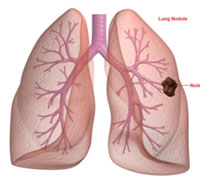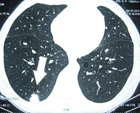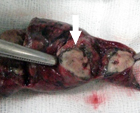

MBBS (AIIMS), MS (Surgery, AIIMS), MNAMS, FACS (USA), FICS (USA), FUICC
Tue, 16 Jan 2024
.webp)
Lung nodules, which are frequently yet unintentionally found during imaging exams, can be a cause of worry for a lot of individuals. Without much information, it can be a reason for harm to them. The nature, origins, and possible hazards of these tiny, oval, or round growths in the tissue of the lungs, which are generally smaller than 3 centimeters in diameter, can be questioned. To know more about the Lung nodules and its treatment option consult Dr Arvind Kumar.
A lung nodule is defined as a "spot" on the lung that is 3 cm (about 1 inches) in diameter or less. If an abnormality is seen on an x-ray of the lungs that is larger than 3 cm, it is considered a "lung mass" instead of a nodule.
Larger lung nodules or lung masses are more likely to be cancerous. Lung nodules usually need to be at least 1 cm in size before they can be seen on a chest x-ray.

Lung nodules typically dont manifest any signs of their own. Typically, they are stumbled upon during regular medical imaging procedures. On the other hand, if a lung nodule grows or causes certain issues,
it might result in symptoms like:
Lung nodules are quite common, and are found on 1 in 500 chest x-rays, and 1 in 100 CT scans of the chest. Roughly half of smokers over the age of 50 will have nodules on a CT scan of their chest. Lung nodules can be either benign (non-cancerous) or malignant (cancer). Many lung nodules do not have any symptoms and are found "accidentally" when a chest x-ray is done for some other reason. Symptoms of Lung nodules include cough or coughing up blood.

Different medical imaging exams, including chest X-rays, CT scans, and sometimes PET scans, frequently reveal lung nodules. These imaging tests give doctors precise views of the lungs that enable them to spot nodules and evaluate their features.
Chest X-rays: These common imaging exams can identify lung nodules, but they are less accurate than CT scans in spotting small nodules or ones in particular lung regions.
Computed tomography (CT) scans are quite good at spotting lung nodules. Healthcare practitioners can evaluate the size, form, and placement of the nodules thanks to the precise cross-sectional pictures they give.
PET Scans: Positron emission tomography (PET) scans are frequently utilized to ascertain the cancerousness of lung nodules. By assessing the metabolic processes of the nodules, this examination can assist in identifying benign from malignant nodules.
When lung nodules are found, more testing is usually required to ascertain their nature and the best course of treatment.
A CT scan of the chest or a PET scan can help in determining the cause. However, the final answer lies in Biopsy of the nodule, via

Occupational exposures, past lung infections, and, less frequently, lung cancer or other severe illnesses, can all be causes of lung nodules. Some of the types of lung nodules are:
Benign Lung Nodules: Several lung nodules are harmless, non-cancerous growths. Infections, inflammatory processes, and other non-cancerous illnesses may have caused them in the past.
Malignant Lung Nodules: Certain lung nodules are malignant and may be a sign of lung cancer or of cancer that has metastasized and spread to other regions of the body from the lung.
Lung nodules that are infectious: Lung nodules that are infectious, such as fungal infections or bacterial infections, can develop.
Malignant lung nodules may be more likely as a result of several risk factors, including:
Smoking: Lung cancer, which can appear as cancerous lung nodules, is more likely to develop in smokers.
Age: The risk of lung cancer grows with advancing years, and elderly people may be more likely to develop malignant nodules.
Environmental Toxins: Exposure to environmental contaminants such as asbestos or radon gas over an extended period of time can increase the chance of developing lung cancer.
Watchful waiting: When lung nodules are tiny and thought to have a low risk of developing into cancer, doctors may advise regular observation with follow-up imaging scans to look for developments over time.
Biopsy: Whenever malignancy is thought to be present, a biopsy is carried out to collect a sample of tissue which is taken from the lesion for testing. This supports the detection of cancer and identifies the kind of malignancy
Surgery: For bigger or questionable nodules, particularly if malignancy is found, surgical excision of the nodule or a piece of the lung may be required.
Radiation Therapy: Malignant lung nodules can occasionally be treated with radiation treatment, especially if surgery doesnt seem to be a feasible option.
Chemotherapy: To combat cancerous cells in the lungs as well as additional afflicted regions in more severe forms of lung cancer, chemotherapy medications may be recommended.
Immunotherapy: This ground-breaking kind of treatment uses the immune system to combat cancer cells and has demonstrated favorable outcomes in the treatment of lung cancer.
Lung nodules may pose a cause of worry and confusion, but effective care depends on early discovery and a thorough understanding of their characteristics. The importance of speaking with a medical expert if you or someone you care about has been given a diagnosis of lung nodules cannot be overstated. Keep in mind that a lot of nodules are benign and might not need immediate medical attention. You may choose the best line of treatment for your unique circumstances by consulting with your medical professionals frequently.
Copyright @ (Prof.) Dr. Arvind Kumar. All Rights Reserved / Thoracic Surgical Oncologis
License Number: U.P State Medical Council (India) No. 27637
